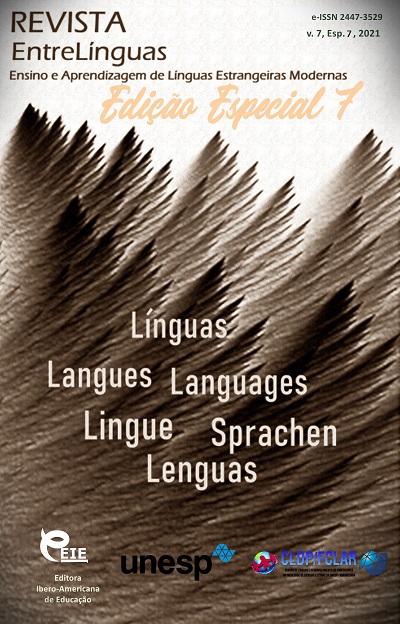Projeto de linguística histórica de estudos eslávicos de 1958
DOI:
https://doi.org/10.29051/el.v7iesp.7.16269Palavras-chave:
Estudos eslavos, Linguística histórica, Identidade nacional, HistoriografiaResumo
O artigo explora os paradoxos da metodologia e dos contextos políticos do projeto de lingüística histórica dos estudos eslavos, que foi oficialmente declarado durante o IV Congresso Internacional de Eslavos (Moscou, 1958). Os autores exploram esse significativo projeto da linguística histórica do ponto de vista da história intelectual - por meio do problema da formação de ideias dos pesquisadores sobre o tema, o método e a metalinguagem dos estudos eslavos, o que se revelou essencial no estudo. da história desta disciplina. A análise semiótica de todo o corpo de fontes como um único texto de ideologia é utilizada para atingir o objetivo do estudo. O projeto da linguística histórica da eslavística (1958) é um fato da história da disciplina e da ideologia que revela a relação entre a metodologia de pesquisa e as práticas de poder e projetos globais de construção da identidade nacional.
Downloads
Referências
Antonova, N.V., Myagkov, G.P., & Nikolaeva, O.A. (2019). Genesis problem of philosophical thought in spanish historiography”, Utopia y Praxis Latinoamericana, 24(5), 65-71.
Belov, M.V. (2007). At the origin of Serbian national ideology: mechanisms of formation and specifics of development: end of XVIIIth - mid-30s of XIX century, St. Petersburg: Aleteya, 540 p.
Bukharaev, V.M., Myagkov, G.P., & Nabiev, B.R. (2016). The philistine in Russian province at the junction of XIX and XX centuries: Modernization measurement”, Man in India, 96(3), 813-820.
Dyurishin, D. (1993). Problems of special interliterary communities, Moscow: Nauka; Vostochnaya literature, 264 p.
Lapteva, L.P. (2005). History of Slavic studies in Russia in the 19th century, Moscow: Indrik, 848 p.
Mayorova, O.N. (2001). Slavic Congress of 1867: The metaphors of celebration”, New Literary Review, 51, 89-110.
Nedashkovskii, L.F. (2009). Economy of the Golden Horde population. Anthropology & Archaeology of Eurasia, 48(2), 35-50.
https://doi.org/10.2753/AAE1061-1959480203
Nedashkovsky, L.F. (2012). Golden Horde Antiquities: The development of research ideas. Acta Archaeologica, 83(1), 225-255.
https://doi.org/10.1111/j.1600-0390.2012.00690.x
Nedashkovsky, L.F. (2014). Agriculture, Cattle Breeding and Trade in the Golden Horde Based on Data from Written Sources. Terra Sebus: Acta Musei Sabesiensis, Special Issue. Russian Studies. From the early Middle Ages to the present day, 291-303.
Nedashkovsky, L.F. (2015). Trade in the Golden Horde Volga Region”, Journal of Sustainable Development, 8(7), 199-206. https://doi.org/10.5539/jsd.v8n7p199
Nedashkovsky, L.F. (2016). Intensity of the economic development of the lower Volga region during the golden horde epoch (by the materials of the cities' environs). Stratum Plus, 6, 151-162.
Nedashkovsky, L.F. (2018). Chemical composition of non-ferrous artifacts from the Golden Horde settlements of the northern areas of the Lower Volga region. Stratum Plus, 6, 243-254.
Nedashkovsky, L.F., & Nedashkovskaya, N.I. (2016). The History of Study of Slavic Antiquities by the First University Slavists of Russia in the Context of Nation-Building Ideas Development. Man in India, 96(3), 719-726.
Nedashkovsky, L.F., & Nurkhamitov, M.R. (2019). Historical characteristics of the Golden Horde city. Opcion, Ano 35, Especial, 23, 288-302.
Nedashkovsky, L.F., & Shigapov, M.B. (2019). Arms and horse harness from Bagaevka settlement. Stratum Plus, 5, 167- 177.
https://doi.org/10.31857/S086960630008260-5
Nedashkovsky, L.F., Sitdikov, A.G., & Asylgaraeva, G.Sh. (2018). Ad memoriam A.G. Mukhamadiev (1933–2018). Povolzhskaya Arkheologiya, 2(24), 348-353. https://doi.org/10.24852/pa2018.2.24.348.353
Prokof’eva, N.A. (1980). International Commission on the History of Slavistics”, Slavic studies and Balkan studies abroad: Compendium of articles and materials, Moscow: Nauka, 34- 39.
Repina, L.P. (2012). National temperament’ and ‘the image of the other. Dialogue with time, 39, 9-19.
Sibinovich, M. (1995). Some topical issues of modern Slavistics”, Bulletin of the Moscow university. Series 9. Philology, 6, 21- 31.
Wolff, L. (1994). Inventing Eastern Europe: The Map of Civilization on the Mind of the Enlightenment, Stanford: Stanford University Press, 419 p.
Yagich, I.V. (2003). The history of Slavic philology: to the study of the discipline. Reprint of 1910, Мoscow: Indrik, 976 p.
Downloads
Publicado
Como Citar
Edição
Seção
Licença

Este trabalho está licenciado sob uma licença Creative Commons Attribution-NonCommercial-ShareAlike 4.0 International License.
Os manuscritos aceitos e publicados são de propriedade da Revista EntreLínguas. Os artigos publicados e as referências citadas na Revista EntreLínguas são de inteira responsabilidade de seus autores.
Transferência de direitos autorais – autorização para publicação
Caso o artigo submetido seja aprovado para publicação, já fica acordado que o(s) autor(es) autoriza(m) a UNESP a reproduzi-lo e publicá-lo na EntreLínguas, entendendo-se os termos “reprodução” e “publicação” conforme definição respectivamente dos incisos VI e I do artigo 5° da Lei 9610/98. O artigo poderá ser acessado pela rede mundial de computadores (Internet), sendo permitidas, a título gratuito, a consulta e a reprodução de exemplar do artigo para uso próprio de quem a consulta, desde que haja a citação ao texto consultado. Essa autorização de publicação 328 EntreLínguas, Araraquara, v. 1, n .2, p. 323-328, jul./dez. 2015 não tem limitação de tempo, ficando a UNESP responsável pela manutenção da identificação do(s) autor(es) do artigo. Os artigos publicados e as referências citadas na Revista EntreLínguas são de inteira responsabilidade de seus autores.











